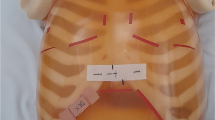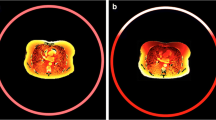Abstract
In-plane shields have been shown to reduce CT radiation dose to some of the most radiosensitive organs. However, potential for artifacts and changes in attenuation numbers make their universal use controversial for radiation protection purposes. In this chapter, we discuss advantages and disadvantages of use of in-plane shielding for reducing radiation dose associated with CT scanning.
Access this chapter
Tax calculation will be finalised at checkout
Purchases are for personal use only
Similar content being viewed by others
References
Beaconsfield T, Nicholson R, Thornton A, Al-Kutoubi A (1998) Would thyroid and breast shielding be beneficial in CT of the head? Eur Radiol 8(4):664–667
Brenner DJ, Hall EJ (2007) Computed tomography—an increasing source of radiation exposure. N Engl J Med 357(22):2277–2284
Brnic Z et al (2003) Efficacy of breast shielding during CT of the head. Eur Radiol 13(11):2436–2440
Catuzzo P et al (2010) Dose reduction in multislice CT by means of bismuth shields: results of in vivo measurements and computed evaluation. Radiol Med 115(1):152–169
Chang KH et al (2010) Dose reduction in CT using bismuth shielding: measurements and Monte Carlo simulations. Radiat Prot Dosimetry 138(4):382–388
Chatterson LC, Leswick DA, Fladeland DA, Hunt MM, Webster ST (2011) Lead versus bismuth-antimony shield for fetal dose reduction at different gestational ages at CT pulmonary angiography. Radiology 260(2):560–579 (Epub ahead of print)
Cohnen M et al (2003) Effective doses in standard protocols for multi-slice CT scanning. Eur Radiol 13(5):1148–1153
Colombo P et al (2004) Evaluation of the efficacy of a bismuth shield during CT examinations. Radiol Med 108(5–6):560–568
Coursey C et al (2008) Pediatric chest MDCT using tube current modulation: effect on radiation dose with breast shielding. AJR Am J Roentgenol 190(1):W54–W61
Dauer LT et al (2007) Radiation dose reduction at a price: the effectiveness of a male gonadal shield during helical CT scans. BMC Med Imaging 7:5
Dobbs M, Ahmed R, Patrick LE (2011) Bismuth breast and thyroid shield implementation for pediatric CT. Radiol Manage 33(1):18–22 quiz 23–4
Doshi SK, Negus IS, Oduko JM (2008) Fetal radiation dose from CT pulmonary angiography in late pregnancy: a phantom study. Br J Radiol 81(968):653–658
Fricke BL DL, Frush DP, Yoshizumi T, Varchena V, Poe SA, Lucaya J (2003) In-plane bismuth breast shields for pediatric CT: effects on radiation dose and image quality using experimental and clinical data. Am J Roentgenol 180(2):407–411
Fujibuchi T et al (2004) Shielding effect of protective seats during CT examination. Nippon Hoshasen Gijutsu Gakkai Zasshi 60(12):1730–1738
Geleijns J et al (2006) Quantitative assessment of selective in-plane shielding of tissues in computed tomography through evaluation of absorbed dose and image quality. Eur Radiol 16(10):2334–2340
Geleijns J, Wang J, McCollough C (2010) The use of breast shielding for dose reduction in pediatric CT: arguments against the proposition. Pediatr Radiol 40(11):1744–1747
Heaney DE, Norvill CA (2006) A comparison of reduction in CT dose through the use of gantry angulations or bismuth shields. Australas Phys Eng Sci Med 29(2):172–178
Hein E et al (2002) Low-dose CT of the paranasal sinuses with eye lens protection: effect on image quality and radiation dose. Eur Radiol 12(7):1693–1696
Hidajat N et al (1996) The efficacy of lead shielding in patient dosage reduction in computed tomography. Rofo 165(5):462–465
Hohl C et al (2005) Radiation dose reduction to the male gonads during MDCT: the effectiveness of a lead shield. AJR Am J Roentgenol 184(1):128–130
Hohl C et al (2006) Radiation dose reduction to breast and thyroid during MDCT: effectiveness of an in-plane bismuth shield. Acta Radiol 47(6):562–567
Hopper KD (2002) Orbital, thyroid, and breast superficial radiation shielding for patients undergoing diagnostic CT. Semin Ultrasound CT MR 23(5):423–427
Hopper KD, King SH, Lobell ME, TenHave TR, Weaver JS (1997) The breast: in-plane X-ray protection during diagnostic thoracic CT—shielding with bismuth radioprotective garments. Radiology 205(3):853–858
Hopper KD et al (2001) Radioprotection to the eye during CT scanning. AJNR Am J Neuroradiol 22(6):1194–1198
Hurwitz LM, Yoshizumi T,, Reiman RE, Goodman PC, Paulson EK, Frush DP, Toncheva G, Nguyen G, Barnes L (2006) Radiation dose to the fetus from body MDCT during early gestation. AJR Am J Roentgenol 186(3):871–876
Hurwitz LM et al (2006b) Radiation dose to the female breast from 16-MDCT body protocols. AJR Am J Roentgenol 186(6):1718–1722
Iball GR, Kennedy EV, Brettle DS (2008) Modelling the effect of lead and other materials for shielding of the fetus in CT pulmonary angiography. Br J Radiol 81(966):499–503
ICRP (2003) ICRP publication 90: biological effects after prenatal irradiation. ICRP, Oxford, UK
Kalra MK et al (2004) Strategies for CT radiation dose optimization. Radiology 230(3):619–628
Kalra MK et al (2009) In-plane shielding for CT: effect of off-centering, automatic exposure control and shield-to-surface distance. Korean J Radiol 10(2):156–163
Keil B et al (2008) Protection of eye lens in computed tomography—dose evaluation on an anthropomorphic phantom using thermo-luminescent dosimeters and Monte-Carlo simulations. Rofo 180(12):1047–1053
Kennedy EV, Iball GR, Brettle DS (2007) Investigation into the effects of lead shielding for fetal dose reduction in CT pulmonary angiography. Br J Radiol 80(956):631–638
Kim S, Frush DP, Yoshizumi TT (2010) Bismuth shielding in CT: support for use in children. Pediatr Radiol 40(11):1739–1743
Kojima H, Tsujimura A, Yabe H (2011) Usefulness of the adaptive dose shield for the infant CT. Nippon Hoshasen Gijutsu Gakkai Zasshi 67(1):57–61
Lee K et al (2010) Dose reduction and image quality assessment in MDCT using AEC (D-DOM & Z-DOM) and in-plane bismuth shielding. Radiat Prot Dosimetry 141(2):162–167
Lee YH, Park ET, Cho PK, Seo HS, Je BK, Suh SI, Yang KS (2011) Comparative analysis of radiation dose and image quality between thyroid shielding and unshielding during CT examination of the neck. AJR Am J Roentgenol 196(3):611–615
Leswick DA et al (2008) Thyroid shields versus z-axis automatic tube current modulation for dose reduction at neck CT. Radiology 249(2):572–580
Mayo JR, Aldrich J, Muller NL (2003) Radiation exposure at chest CT: a statement of the Fleischner Society. Radiology 228(1):15–21
McLaughlin DJ, Mooney RB (2004) Dose reduction to radiosensitive tissues in CT. Do commercially available shields meet the users’ needs? Clin Radiol 59(5):446–450
Mukundan S Jr et al (2007) MOSFET dosimetry for radiation dose assessment of bismuth shielding of the eye in children. Am J Roentgenol 188(6):1648–1650
National Radiological Protection Board RCoR (1998) Diagnostic medical exposures: advice on exposure to ionising radiation during pregnancy. NRPB, Didcot, UK
Neeman Z et al (2006) CT fluoroscopy shielding: decreases in scattered radiation for the patient and operator. J Vasc Interv Radiol 17(12):1999–2004
Ngaile JE et al (2008) Use of lead shields for radiation protection of superficial organs in patients undergoing head CT examinations. Radiat Prot Dosimetry 130(4):490–498
Parker MS, Chung JK, Fatouros PP, Hoots JA, Kelleher NM, Benedict SH (2006) Reduction of radiation dose to the female breast: Preliminary data with a custom-designed tungsten-antimony composite breast shield. Journal of Applied Research 6(3):230–239
Parker MS et al (2008) Absorbed radiation dose of the female breast during diagnostic multidetector chest CT and dose reduction with a tungsten-antimony composite breast shield: preliminary results. Clin Radiol 63(3):278–288
Perisinakis K et al (2005) Reduction of eye lens radiation dose by orbital bismuth shielding in pediatric patients undergoing CT of the head: a Monte Carlo study. Med Phys 32(4):1024–1030
Preston DL et al (2007) Solid cancer incidence in atomic bomb survivors: 1958–1998. Radiat Res 168(1):1–64
Price R, Halson P, Sampson M (1999) Dose reduction during CT scanning in an anthropomorphic phantom by the use of a male gonad shield. Br J Radiol 72(857):489–494
Raissaki M et al (2010) Eye-lens bismuth shielding in paediatric head CT: artefact evaluation and reduction. Pediatr Radiol 40(11):1748–1754
Romanowski CA, Underwood AC, Sprigg A (1994) Reduction of radiation doses in leg lengthening procedures by means of audit and computed tomography scanogram techniques. Br J Radiol 67(803):1103–1107
Rubin P, Casarett GW (1968) Clinical radiation pathology as applied to curative radiotherapy. Cancer 22(4):767–778
Schonfeld SJ, Lee C, Berrington de Gonzalez A (2011) Medical exposure to radiation and thyroid cancer. Clin Oncol (R Coll Radiol) 23(4):244–250
Takada K, Kaneko J, Aoki K (2009) Breast dose reduction in female CT screening for lung cancer using various metallic shields. Nippon Hoshasen Gijutsu Gakkai Zasshi 65(12):1628–1637
The 2007 recommendations of the International Commission on Radiological Protection. ICRP publication 103. Ann ICRP 37(2–4):1–332
Tsujino K et al (2003) Predictive value of dose-volume histogram parameters for predicting radiation pneumonitis after concurrent chemoradiation for lung cancer. Int J Radiat Oncol Biol Phys 55(1):110–115
Vollmar SV, Kalender WA (2008) Reduction of dose to the female breast in thoracic CT: a comparison of standard-protocol, bismuth-shielded, partial and tube-current-modulated CT examinations. Eur Radiol 18(8):1674–1682
Winer-Muram HT et al (2002) Pulmonary embolism in pregnant patients: fetal radiation dose with helical CT. Radiology 224(2):487–492
Yi A et al (2010) Optimal multidetector row CT parameters for evaluations of the breast: a phantom and specimen study. Acad Radiol 17(6):744–751
Yilmaz MH et al (2007a) Coronary calcium scoring with MDCT: the radiation dose to the breast and the effectiveness of bismuth breast shield. Eur J Radiol 61(1):139–143
Yilmaz MH et al (2007b) Female breast radiation exposure during thorax multidetector computed tomography and the effectiveness of bismuth breast shield to reduce breast radiation dose. J Comput Assist Tomogr 31(1):138–142
Yousefzadeh DK, Ward MB, Reft C (2006) Internal barium shielding to minimize fetal irradiation in spiral chest CT: a phantom simulation experiment. Radiology 239(3):751–758
Author information
Authors and Affiliations
Corresponding author
Editor information
Editors and Affiliations
Rights and permissions
Copyright information
© 2012 Springer-Verlag Berlin Heidelberg
About this chapter
Cite this chapter
Aran, S., Singh, S., Kalra, M.K. (2012). Application of Shielding in CT Radiation Dose Reduction. In: Tack, D., Kalra, M., Gevenois, P. (eds) Radiation Dose from Multidetector CT. Medical Radiology(). Springer, Berlin, Heidelberg. https://doi.org/10.1007/174_2011_450
Download citation
DOI: https://doi.org/10.1007/174_2011_450
Publisher Name: Springer, Berlin, Heidelberg
Print ISBN: 978-3-642-24534-3
Online ISBN: 978-3-642-24535-0
eBook Packages: MedicineMedicine (R0)




